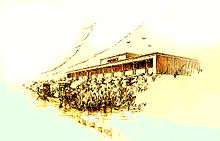Deir el-Ballas
Deir el-Ballas is an archaeological site in Upper Egypt. It was the location of a royal palace and administration center occupied by rulers of the Seventeenth Dynasty in ancient Egypt's late Second Intermediate Period.
Location
Deir el-Ballas was located on the west bank of the Nile, approximately twenty kilometers south of Dendara [1] and some 30 miles north of Thebes (modern-day Luxor).[2]
History
It has not yet been determined who constructed the buildings in this area or when.[3] However, Seqenenre Tao and Kamose, the final two rulers of the Seventeenth Dynasty, are known to have used the palaces.[4] For as yet undetermined reasons the rulers of the succeeding New Kingdom (approximately 1550-1070 BCE) abandoned the site;[5] however, several New Kingdom-era graves were discovered in this area during the 20th century.[6]
Structures

The complex seems to have consisted of several facilities enclosed by a wall measuring 900 by 400 feet.[7] A Northern Palace served as the royal residence[8] with a village for staff members, workers, and artisans built nearby,[9] while a two-storied Southern Palace was used an administrative center.[10] "Also included in the complex were silos and stables, indicating the agricultural interests of the royal family."[11]
According to Margaret Bunson, "the palaces (pero or per-a'a) (of the Second Intermediate Period) always contained two gateways, two main halls, and two administrative sections to reflect the upper and lower regions of the nation. Flagstaffs were used at the gates, as they were placed before temples. The remains of the Seventeenth Dynasty (1640–1550 BCE) palace at Deir el-Ballas, on the western shore north of Thebes, indicate somewhat luxurious surroundings and innovative decoration, following the "double" scheme. In some instances the walls and floors were designed to portray pools of fish and vast tracts of flowering shrubs." [12]
Excavation
Deir el-Ballas "was excavated at the beginning of the twentieth century by George Reisner, Albert Lythgoe, and F.W. Green under the sponsorship of Phoebe A. Hearst. These excavations uncovered a large royal palace, a settlement, and a series of cemeteries dating to the late Second Intermediate Period and the early Eighteenth Dynasty. The results of the Hearst excavations were never published, however, and records of the expedition were inadequate to understand fully the nature and history of the site." [13]
From 1980 to 1986, a second excavation was conducted on the site, sponsored by the Museum of Fine Arts in Boston.[14] Their findings "revealed a site far larger than the Hearst expedition records had indicated, including palace complexes, a group of large houses, and remains of a previously unrecorded ancient settlement."[15]
Some significant items discovered in this area include a brick inscribed with the name of the pharaoh Djehuti from the Second Intermediate Period[16] and the Hearst papyrus, a Middle Kingdom-era medical text discovered in the area by an Egyptian peasant around the turn of the 20th century.[17]
See also
- http://www.isis-und-osiris.de/isisosiris/main/phpBB2/viewtopic.php?p=124575
- http://drdanieljackson.dr.funpic.de/qena/deir_el-ballas/deir_el-ballas1.php
- http://id.loc.gov/authorities/subjects/sh90003836.html
- Richard A. Parker, Journal of the American Research Center in Egypt, Vol. 2, (1963), pp. 113–116. Published by: American Research Center in Egypt.JSTOR 40000975
- Peter Lacovara, The New Kingdom Royal City, Routledge 2013. 256 pages. ISBN 978-1-136-16817-8. https://books.google.com/books?id=QL2iwWiMaLsC&dq=New+Kingdom+Royal+City&source=gbs_navlinks_s
References
- ↑ http://www.arce.org/publications/books/u9
- ↑ http://www.fofweb.com/History/HistRefMain.asp?iPin=EEGY0464&SID=2&DatabaseName=Ancient+and+Medieval+History+Online&InputText=%22Deir+el+Ballas%22&SearchStyle=&dTitle=Deir+el-Ballas&TabRecordType=All+Records&BioCountPass=3&SubCountPass=4&DocCountPass=0&ImgCountPass=0&MapCountPass=0&FedCountPass=&MedCountPass=0&NewsCountPass=0&RecPosition=1&AmericanData=&WomenData=&AFHCData=&IndianData=&WorldData=&AncientData=Set&GovernmentData=
- ↑ http://www.fofweb.com/History/HistRefMain.asp?iPin=EEGY0464&SID=2&DatabaseName=Ancient+and+Medieval+History+Online&InputText=%22Deir+el+Ballas%22&SearchStyle=&dTitle=Deir+el-Ballas&TabRecordType=All+Records&BioCountPass=3&SubCountPass=4&DocCountPass=0&ImgCountPass=0&MapCountPass=0&FedCountPass=&MedCountPass=0&NewsCountPass=0&RecPosition=1&AmericanData=&WomenData=&AFHCData=&IndianData=&WorldData=&AncientData=Set&GovernmentData=
- ↑ http://www.fofweb.com/History/HistRefMain.asp?iPin=EEGY0464&SID=2&DatabaseName=Ancient+and+Medieval+History+Online&InputText=%22Deir+el+Ballas%22&SearchStyle=&dTitle=Deir+el-Ballas&TabRecordType=All+Records&BioCountPass=3&SubCountPass=4&DocCountPass=0&ImgCountPass=0&MapCountPass=0&FedCountPass=&MedCountPass=0&NewsCountPass=0&RecPosition=1&AmericanData=&WomenData=&AFHCData=&IndianData=&WorldData=&AncientData=Set&GovernmentData=
- ↑ http://www.fofweb.com/History/HistRefMain.asp?iPin=EEGY0464&SID=2&DatabaseName=Ancient+and+Medieval+History+Online&InputText=%22Deir+el+Ballas%22&SearchStyle=&dTitle=Deir+el-Ballas&TabRecordType=All+Records&BioCountPass=3&SubCountPass=4&DocCountPass=0&ImgCountPass=0&MapCountPass=0&FedCountPass=&MedCountPass=0&NewsCountPass=0&RecPosition=1&AmericanData=&WomenData=&AFHCData=&IndianData=&WorldData=&AncientData=Set&GovernmentData=
- ↑ http://www.fofweb.com/History/HistRefMain.asp?iPin=EEGY0464&SID=2&DatabaseName=Ancient+and+Medieval+History+Online&InputText=%22Deir+el+Ballas%22&SearchStyle=&dTitle=Deir+el-Ballas&TabRecordType=All+Records&BioCountPass=3&SubCountPass=4&DocCountPass=0&ImgCountPass=0&MapCountPass=0&FedCountPass=&MedCountPass=0&NewsCountPass=0&RecPosition=1&AmericanData=&WomenData=&AFHCData=&IndianData=&WorldData=&AncientData=Set&GovernmentData=
- ↑ http://www.fofweb.com/History/HistRefMain.asp?iPin=EEGY0464&SID=2&DatabaseName=Ancient+and+Medieval+History+Online&InputText=%22Deir+el+Ballas%22&SearchStyle=&dTitle=Deir+el-Ballas&TabRecordType=All+Records&BioCountPass=3&SubCountPass=4&DocCountPass=0&ImgCountPass=0&MapCountPass=0&FedCountPass=&MedCountPass=0&NewsCountPass=0&RecPosition=1&AmericanData=&WomenData=&AFHCData=&IndianData=&WorldData=&AncientData=Set&GovernmentData=
- ↑ http://www.fofweb.com/History/HistRefMain.asp?iPin=EEGY0464&SID=2&DatabaseName=Ancient+and+Medieval+History+Online&InputText=%22Deir+el+Ballas%22&SearchStyle=&dTitle=Deir+el-Ballas&TabRecordType=All+Records&BioCountPass=3&SubCountPass=4&DocCountPass=0&ImgCountPass=0&MapCountPass=0&FedCountPass=&MedCountPass=0&NewsCountPass=0&RecPosition=1&AmericanData=&WomenData=&AFHCData=&IndianData=&WorldData=&AncientData=Set&GovernmentData=
- ↑ http://www.fofweb.com/History/HistRefMain.asp?iPin=EEGY0464&SID=2&DatabaseName=Ancient+and+Medieval+History+Online&InputText=%22Deir+el+Ballas%22&SearchStyle=&dTitle=Deir+el-Ballas&TabRecordType=All+Records&BioCountPass=3&SubCountPass=4&DocCountPass=0&ImgCountPass=0&MapCountPass=0&FedCountPass=&MedCountPass=0&NewsCountPass=0&RecPosition=1&AmericanData=&WomenData=&AFHCData=&IndianData=&WorldData=&AncientData=Set&GovernmentData=
- ↑ http://www.fofweb.com/History/HistRefMain.asp?iPin=EEGY0464&SID=2&DatabaseName=Ancient+and+Medieval+History+Online&InputText=%22Deir+el+Ballas%22&SearchStyle=&dTitle=Deir+el-Ballas&TabRecordType=All+Records&BioCountPass=3&SubCountPass=4&DocCountPass=0&ImgCountPass=0&MapCountPass=0&FedCountPass=&MedCountPass=0&NewsCountPass=0&RecPosition=1&AmericanData=&WomenData=&AFHCData=&IndianData=&WorldData=&AncientData=Set&GovernmentData=
- ↑ http://www.fofweb.com/History/HistRefMain.asp?iPin=EEGY0464&SID=2&DatabaseName=Ancient+and+Medieval+History+Online&InputText=%22Deir+el+Ballas%22&SearchStyle=&dTitle=Deir+el-Ballas&TabRecordType=All+Records&BioCountPass=3&SubCountPass=4&DocCountPass=0&ImgCountPass=0&MapCountPass=0&FedCountPass=&MedCountPass=0&NewsCountPass=0&RecPosition=1&AmericanData=&WomenData=&AFHCData=&IndianData=&WorldData=&AncientData=Set&GovernmentData=
- ↑ Bunson, Margaret. "art and architecture in ancient Egypt." Encyclopedia of Ancient Egypt, Revised Edition. New York: Facts On File, Inc., 2002. Ancient and Medieval History Online. Facts On File, Inc. http://www.fofweb.com/activelink2.asp? ItemID=WE49&iPin=EEGY0223&SingleRecord=True (accessed February 11, 2014).
- ↑ http://www.arce.org/publications/books/u9
- ↑ http://www.arce.org/publications/books/u9
- ↑ http://www.arce.org/publications/books/u9
- ↑ Christina Geisen, Zur zeitlichen Einordnung des Königs Djehuti an das Ende der 13. Dynastie, Studien zur Altägyptischen Kultur, Bd. 32, (2004), pp. 149-157
- ↑ http://web.archive.org/web/20031210014002/http://tebtunis.berkeley.edu/collection/medical.html
Coordinates: 26°01′00″N 32°46′00″E / 26.0168°N 32.7667°E